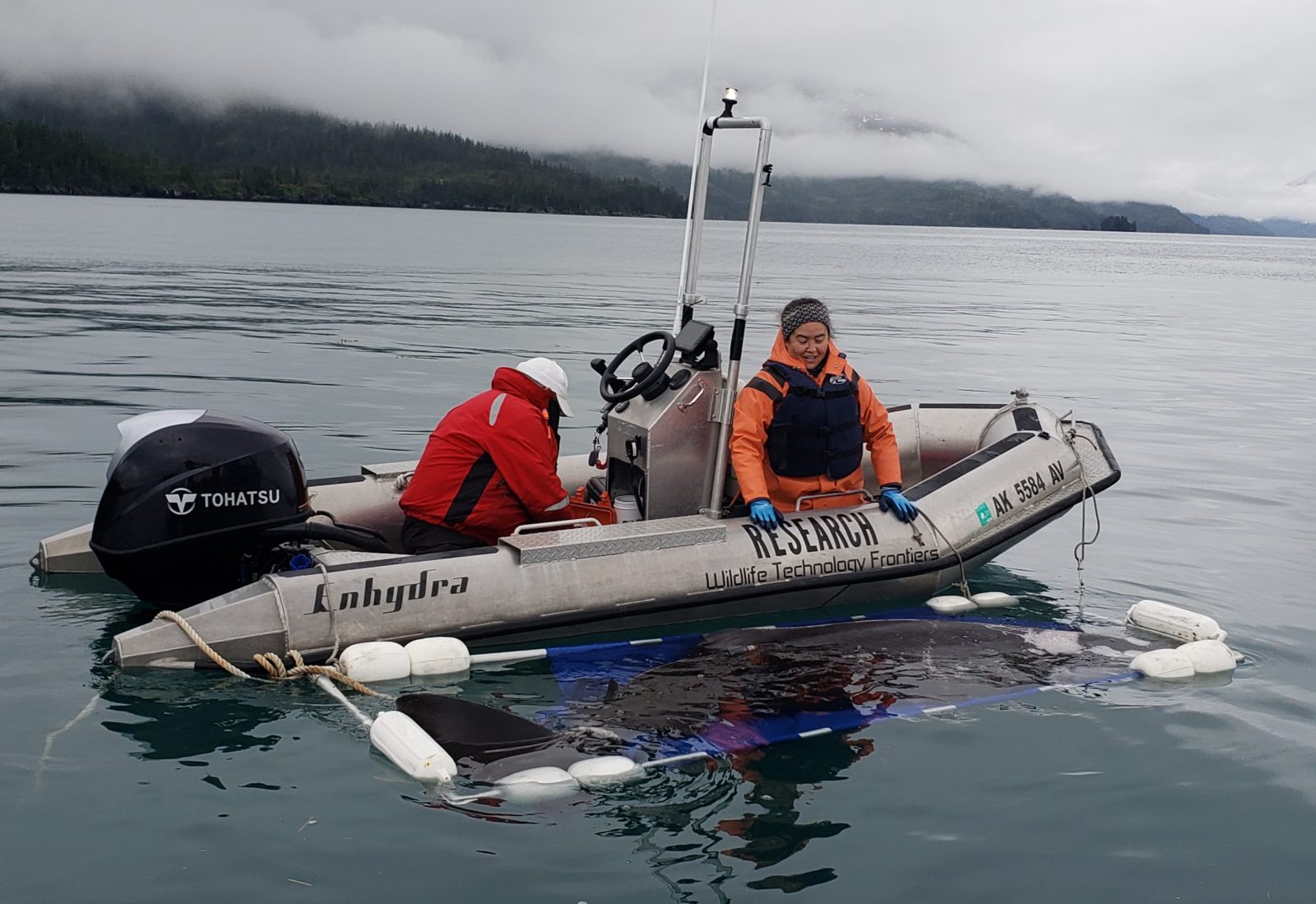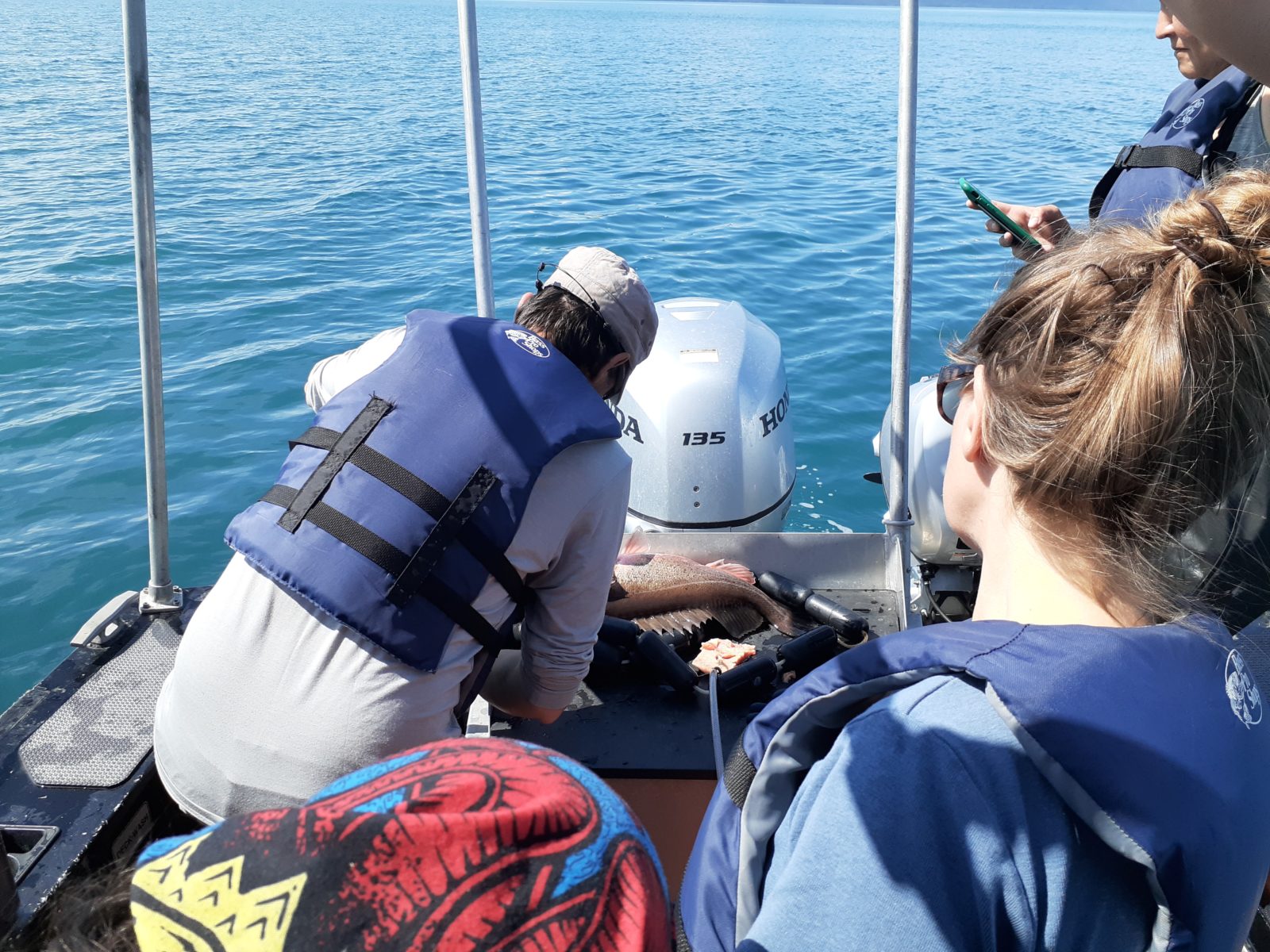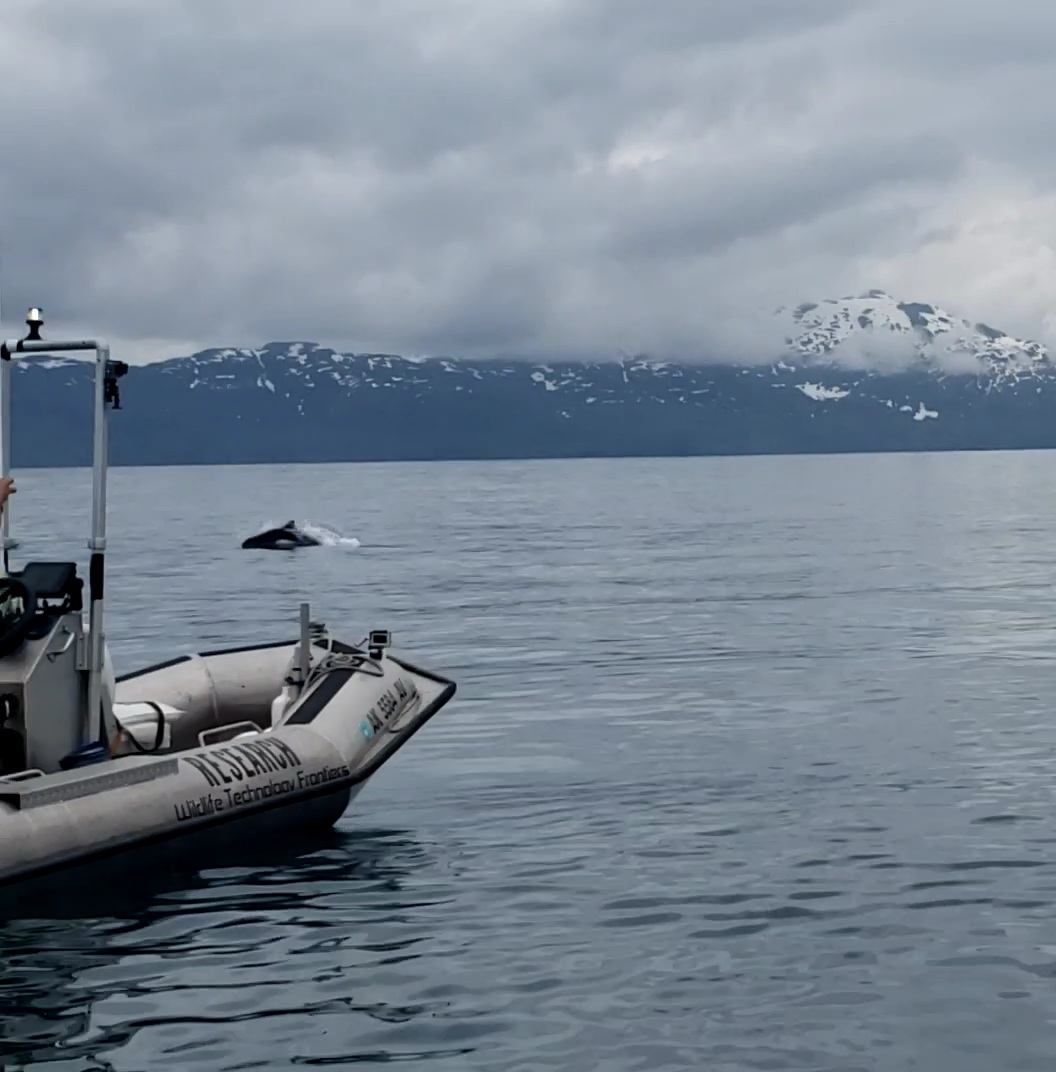This summer, AOOS is supporting a student from the Alaska Native Science and Engineering Program to work on a sleeper shark research project under the direction of Dr. Markus Horning. Nadia Barcelona will be sending regular notes from the field. Read her field notes from “Sleeper Sharks: Episode 3”! You can also read her previous notes below.
Episode 3: Sharks! And Rain…
It’s the end of episode 3, and we managed to pull in 2 more sleeper sharks! This week was filled with rainy days, and foggy visibility. It was a little rougher on the water as well so we pulled out a day early, but I don’t think the sharks minded too much. The cabin we stayed at was much cozier than the previous, and the 5 of us Markus, Michelle, Erin and John, got to know each other very well in those close quarters.

The sleeper sharks we caught this week were both juveniles, one male at 2.4 meters long, and one female at about 3 meters (this one I dubbed my favorite so far). It was very interesting to see the wide variation of color, physique and size of these juvenile sharks. Like most fish, Sleeper sharks are covered in a casing of “slime,” and the slime around these sharks is what gives them this brackish, grey color. But occasionally, maybe when brushing past a rock or getting entangled in a fishing line, the slime will rub off and reveal the true color of the sleeper sharks: white! Both of these sharks are mainly grey colored, but the (assumed) older and bigger shark, has many more spots of white, the origins of which we can only speculate about. It’s unknown whether this slime coating regenerates over the sharks’ lifetimes, or if they’re born with it. But it seems to serve an important purpose, and could mean the difference between the sleeper sharks having stealthy camouflage or acting like a bright white beacon.
Does this play a role in the sharks’ predation on seals, fish and squid? Does it affect the individual sharks’ fitness and survivability in the wild? A lot of these questions can only be speculated upon through information gained from its Greenland shark cousin, or other similar fishes. This is why more research is needed on these curious sharks; there is so much about them that we don’t know yet!


Episode 2: Sharking continues (without sharks)
For the first day of episode two, we picked up Thomas, Jill, Erin and Julie, and the 6 of us got ready to go sharking the next day. This week was very special, it was filled with multiple sightings of many different marine animals: sea otters, harbor seals, river otters, Dall’s porpoises, humpback and grey whales! From the bay we saw a gang of river otters traversing the ocean, and a group of Dall’s Porpoises put on a show for us while we picked up our shark lines during the week.

On our 5th day we even caught a rockfish on one of our lines which came with a unique problem to solve. Since they tend to stay at one depth of the water column unlike some other fishes, the rockfish have a swim bladder to help regulate buoyancy. So when brought up to the surface like ours was, the swim bladder will expand and rockfish will float at the surface of the water. It will eventually die unless it can be brought back down to depth and deflate its swim bladder again. The mechanism we used was a weighted milk crate with the opening faced-down so the fish would be unable to float back up. We lowered the little guy back down to 100+ feet of water, allowing the fish to swim out from under the crate when his swim bladder reinflated/pressurized.

The only thing we didn’t see this week was a shark (Erin claims to have seen one trailing our shark line as we pulled it into the boat). But that’s okay, we have an entire summer to tag more! Anywho, sleeper sharks are very hard to fish for, and most of the sleeper sharks that have been caught in Alaska were caught as by-catch. They are very slow moving with slow metabolisms, so they may even eat only once every 1-2 weeks. Factor in the lack of information surrounding them, and it becomes very hard to determine where they might be in the depths. Amy, from the first week, had mapped out Prince William sound with all the different salmon runs that occurred here. This helped us choose the spots we wanted to drop our lines, since we believe the sleeper sharks might hover around those salmon runs in the summer. From the little previous data that we have, it also seems likely that the sharks like to stay near the bottom of “walls” in the ocean, right before the ground inclines sharply to shallow waters. Since they are so energy-conserving, they probably don’t like to climb up the steep ocean walls and, in a way, might be governed by the geography and layout of the Sound’s ocean floor.
Regardless of any sharks caught or missed, it was time to say goodbye to the cabin on July 4th, and take a breather. But I’m excited to go to the next cabin on the next episode to start sharking once again!


Episode 1: Sharking Begins!
Hey everyone! My name is Nadia Barcelona, I am a current undergrad at the University of Alaska, Anchorage studying biology to further my career in field wildlife research. I recently got involved in the Sleeper Shark Project with the help and involvement of the Alaska Ocean Observing System (AOOS), Alaska Native Science and Engineering Program (ANSEP) and Wildlife Technology Frontiers (WTF). The Sleeper Shark Project is led by Dr. Markus Horning (also known as SharkusMarkus; WTF), Dr. Amy Bishop (UAF) and Dr. Julie Nielsen (Kingfisher Marine Research). This project is funded by the North Pacific Research Board and has been around since 2018, but my involvement started 2 years ago when I volunteered for a day to go sharking off of Resurrection Bay. We didn’t catch any that day but as obsessed as I am with sharks, I knew I had to come back. Now, I’m interning at the new research location in Prince William Sound throughout the entire summer, and with very high hopes!

Sleeper sharks (Somniosus pacificus) are the lesser known cousins of Greenland sharks, and are fairly similar in physique and behavior. The sharks, which are often regarded as a nuisance to fisherman, were not the original study subject for Markus, despite the large absence of information surrounding them. But after they became a prime suspect in predation on sea lions, which had not been previously observed, these sharks came to be a main focus for Markus and the Sleeper Shark Project was devised! The project includes taking physical tissue samples such as blood and skin, as well as tagging the animals with transmitters to gather information on the sharks’ habits, movements and environment in the span of a year. This can hopefully help us in better understanding sleeper sharks’ behaviors and how they affect the pacific marine ecosystem around Alaska.
This first session in Prince William Sound included me, Markus, Brett, Amy and Alex. We got to a public use cabin on the 22nd of June, unloaded all our gear with the two boats Tiburon and Enhydra, and got ready to start sharking the next day. The cabin was cozy, with a space heater and slabs of wood to set our sleeping gear. The first step we took for sharking was setting our lines with salmon-baited hooks. We set a line at 4 different locations around the bay in the morning, and we waited… about 5 hours before going out again to check on them. The five of us managed to wrangle up 2 sharks for this first episode, and successfully tagged them both! It was sad to see Amy, Brett, and Alex go, but I’m excited for the next episode!



